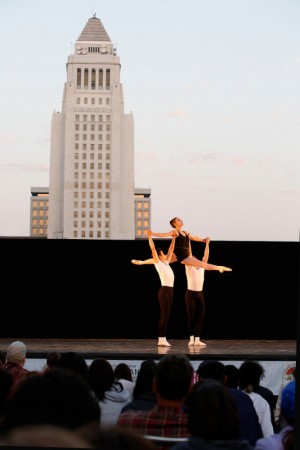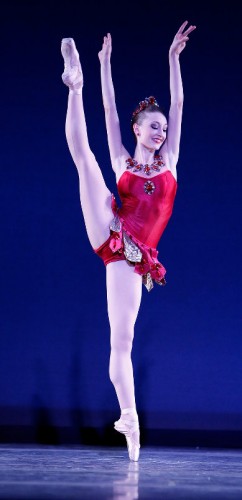 Perhaps it was City Hall — imposing, authoritarian, standing “at attention” behind Grand Park’s platform stage — that riveted the crowd. People were afraid that if they misbehaved, they’d get busted.
Perhaps it was City Hall — imposing, authoritarian, standing “at attention” behind Grand Park’s platform stage — that riveted the crowd. People were afraid that if they misbehaved, they’d get busted.
Or blame it on Balanchine. A huge throng of more than 3,000 respectful onlookers serenely watched Los Angeles Ballet present a double-bill of works by the Russian-born choreographer of New York City Ballet on Saturday. It was part of the Music Center’s free-to-the-public outdoor presentation series in our still-new urban park.
The brilliant dance invention of the long-departed Balanchine commanded the focused attention of even the most casual of picnickers.
 Two of the maestro’s great creations were offered: First came “Agon” (1957) Balanchine’s miraculous black-and-white jigsaw-puzzle-vivante, set to a thorny commissioned score by Stravinsky. Then, in a flush of red, came “Rubies” (1967) the middle bit of the full-length “Jewels”: playful, regal, magnetic, and also set to Stravinsky.
Two of the maestro’s great creations were offered: First came “Agon” (1957) Balanchine’s miraculous black-and-white jigsaw-puzzle-vivante, set to a thorny commissioned score by Stravinsky. Then, in a flush of red, came “Rubies” (1967) the middle bit of the full-length “Jewels”: playful, regal, magnetic, and also set to Stravinsky.
The program suited our cinema town. First we had black and white; then we had color.
The public’s embrace of the ballet be-in astonished even the Music Center’s Director of Programming Renae Williams Niles, who introduced the performance. Picnickers arranged their blankets in a colorful checkerboard along the gently graded hill. Viewers covered all sit-able space — all to watch classical ballet!
Lending the evening a cozy vibe was audience patter from L.A. Ballet co-artistic director Colleen Neary, the former New York City Ballet principal dancer who along with husband Thordal Christensen runs the company. Neary nattered charming Balanchine nuggets: She imitated his nasal twang and how he called everyone “dear”; she recalled his i.d.’ing ballerinas by their perfume and his dispatching her to study jazz dance with Luigi.
I especially appreciated Neary’s mentioning Balanchine’s life in Los Angeles and his choreography for “The Goldwyn Follies” (1938) on his then-wife Vera Zorina.
 It shows that the troupe has been on an aggressive performance schedule in traditional theaters around town. They have improved.
It shows that the troupe has been on an aggressive performance schedule in traditional theaters around town. They have improved.
Even on an outdoor stage, a relatively insecure performance platform, the female contingent, in particular, took every available risk; thrusting long legs to perilously high extensions and stabbing at the floorboard with precise pointe work.
“Agon” was the better danced of the ballets; its visual concepts, stark shapes, and extreme modernity seemed more under the company’s command. “Rubies” lacked that big-picture grasp and when the full cast was on stage, it veered into messiness. The men lapse in and out of finesse in their arm placement, straying into a kind of in-between vee that isn’t quite ballet classicism. I like Kenta Shimizu’s on-stage energy; he’s such a nice dancer and a noble partner to Allynne Noelle and Julia Cinquemani. Both women brandish rock-solid technique and the right mix of passion and sublimation of ego that suits Balanchine’s work.
The company was heroic coping with what the park stage had to offer; entries and exits were notably tidy and professional. A great dance night in Los Angeles, resulting in an appreciable notch upward in the city’s dance IQ.
Photo credit, Reed Hutchinson for Los Angeles Ballet

